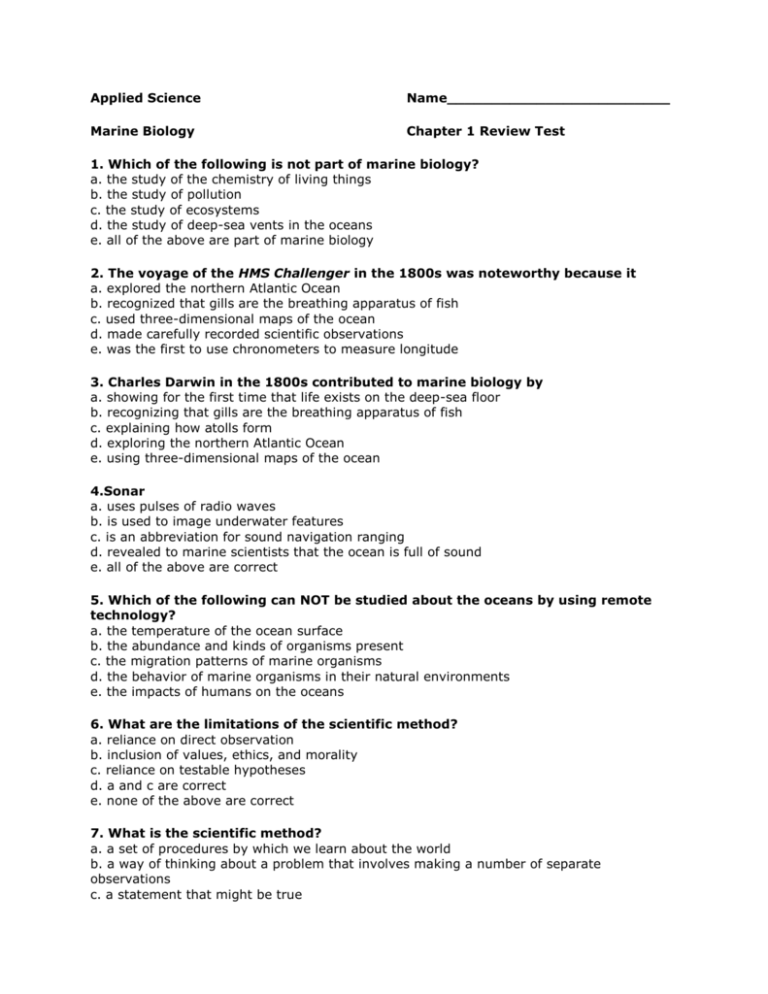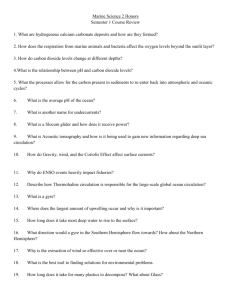Ch1 Practice Test
advertisement

Applied Science Name_________________________ Marine Biology Chapter 1 Review Test 1. Which of the following is not part of marine biology? a. the study of the chemistry of living things b. the study of pollution c. the study of ecosystems d. the study of deep-sea vents in the oceans e. all of the above are part of marine biology 2. The voyage of the HMS Challenger in the 1800s was noteworthy because it a. explored the northern Atlantic Ocean b. recognized that gills are the breathing apparatus of fish c. used three-dimensional maps of the ocean d. made carefully recorded scientific observations e. was the first to use chronometers to measure longitude 3. Charles Darwin in the 1800s contributed to marine biology by a. showing for the first time that life exists on the deep-sea floor b. recognizing that gills are the breathing apparatus of fish c. explaining how atolls form d. exploring the northern Atlantic Ocean e. using three-dimensional maps of the ocean 4.Sonar a. uses pulses of radio waves b. is used to image underwater features c. is an abbreviation for sound navigation ranging d. revealed to marine scientists that the ocean is full of sound e. all of the above are correct 5. Which of the following can NOT be studied about the oceans by using remote technology? a. the temperature of the ocean surface b. the abundance and kinds of organisms present c. the migration patterns of marine organisms d. the behavior of marine organisms in their natural environments e. the impacts of humans on the oceans 6. What are the limitations of the scientific method? a. reliance on direct observation b. inclusion of values, ethics, and morality c. reliance on testable hypotheses d. a and c are correct e. none of the above are correct 7. What is the scientific method? a. a set of procedures by which we learn about the world b. a way of thinking about a problem that involves making a number of separate observations c. a statement that might be true d. a statement which at least potentially can be proven false e. a hypothesis that has been so extensively tested that it is generally regarded as true 8. The HMS Challenger expedition made collections of marine organisms a. around the world b. in the Pacific Ocean only c. in the Atlantic Ocean only d. in the Mediterranean Sea only e. in the North Sea only 9. Which of the following was NOT an important motivation for studying the oceans? a. learning new trade routes b. obtaining food c. finding a ocean route to Switzerland d. obtaining goods for trade e. expanding territories 10. Who was the first European group to explore the Northern Atlantic? a. James Cook b. the Vikings c. the Pacific Islanders d. Charles Darwin e. the HMS Challenger Expedition 11. Which was the first systematic effort to gather data and samples from oceans around the globe? a. the Endeavour expedition b. the Vikings c. the Pacific Islanders d. Charles Darwin and the Beagle e. the Challenger Expedition 12. Which of the following is NOT a part of the techniques and equipment used today in marine biology? a. research vessels b. remotely operated vehicles (ROVs) c. marine laboratories d. chronometers to measure latitude e. remote sensing technology The online test from the book’s website: 1 Marine Biology can best be described as: A) B) C) The study of life The study of the marine environment The study of marine animals D) 2 An oceanographer might study which of the following? A) B) C) D) 3 B) C) D) B) C) D) Yearly oxygen production by salt marsh grasses How mole crabs burrow in sand. Edible shellfish Migrations of whales Giant squid Life in the ocean depths Look at their charts of the South Pole. See the results of experiments in their on-board scientific laboratory. Consult Edward Forbes' reports on the fauna. Compare their deep-sea specimens with those taken by this expedition. The voyages of Captain Cook provided which of the following? A) B) C) D) 6 The influence of the Loop Current on seasonal growth of open-sea algae Modern biologists still might consult the results of the Challenger expedition to A) 5 Heat tolerance of coastal barnacles Ancient people often had knowledge of which of the following? A) 4 All of the above Soundings of the deep sea Reliable navigational charts The first exploration of northern polar regions An explanation for the formation of atolls. One of the earliest influential American marine biologists was A) Malcolm Forbes. B) C) D) 7 B) C) D) B) C) D) B) C) D) The inventor was a marine biologist stationed at Woods Hole. It uses compressed air. It can be used safely to depths of up to 100 m (300 feet). ROV Critter cam Satellite Passive sonar system Marine labs ROVs AUVs Remote sensing Sonar uses pulses of radio waves to probe the depths of the oceans. A) B) 11 It was invented as part of the war effort during World War II. Which new technology has advanced our understanding of large scale ocean features such as ocean currents? A) 10 Louis Agassiz. An example of an underwater robot could be which of the following? A) 9 Victor Andouin. Which is true of scuba gear? A) 8 Ed Ricketts. True False What is the scientific method? A) A way to prove hypotheses correct B) A systematic means of observation and reasoning C) A method that uses induction D) A method that proves educated guesses 12 A scientific theory is used to describe something that is a controversial or provisional hypothesis. A) True B) False 13 Which of the following could be a valid scientific hypothesis? A) Moray eels find their prey primarily by following chemical cues. B) Dolphins communicate by using brain waves. C) It is immoral to keep dolphins in captivity. D) Dogs are superior in regard to seals. 14 A swimmer sees a large blue jellyfish nearby. Jellyfishes are known to sting, so the swimmer moves away. The swimmer did which of the following? A) Used inductive reasoning B) Used deductive reasoning C) Constructed a theory D) Tested a hypothesis 15 A scientific theory has which of the following properties? A) It agrees with available evidence and all alternative hypotheses have been ruled out. B) It cannot be rejected. C) It has been absolutely proven. D) It does not need to be altered in the light of new evidence. 16 A marine biologist wishes to test the hypothesis that heavy grazing by snails causes the alga Ulva to stay short rather than grow upright. Which of the following variables could be manipulated successfully at the seashore to test this hypothesis? A) Add nutrients to the nearby ocean waters to see if the algae grow taller Put a small cage around the algae to keep snails from eating them and then see if the B) protected algae are taller than unprotected ones C) Change the light intensity to see if this causes the algae to stay short D) Redirect ocean waves to see if wave shock causes the algae to stay short 17 Old stories tell of gigantic sea serpents, possibly ancient reptiles called plesiosaurs. To prove that they still exist, the most useful scientific evidence would be which of the following? A) Good photographs of the creatures B) Reliable eye-witness accounts of seeing them C) Unexplained bite marks on fish D) A fresh skull with flesh still attached 18 New technology, such as AUVs, allows scientists to observe marine mammals in which situation? A) In captivity B) From the surface C) From stranded or dead animals D) Underwater in the open sea 19 Automated floats can be used to A) Take pictures of whales and other diving mammals. B) Measure water temperature at 2,000 m. C) Forecast the tracks of hurricanes. D) Identify plankton from their DNA. oceanographer study-B- loop current ancient-A-edible Modern biologists still might-D-compare deep-sea captain cook-B-reliable nav earliest americans-D-Louis Agassiz SCUBA gear-C-Compressed air underh2o robot-A-ROV new tech ocean currents-D-Remote Sensing Sonar-False- Not radio waves SciMeth-B-systematic obs reasoning Sci theory-False-not provisional valid scimeth-A-moray eels swimmer jellyfish-B-deductive sci theory-A-agrees marine bio snails-B-cage old stories-D-skull new tech auv-D-underwater open sea automated floats-B-temp measure








